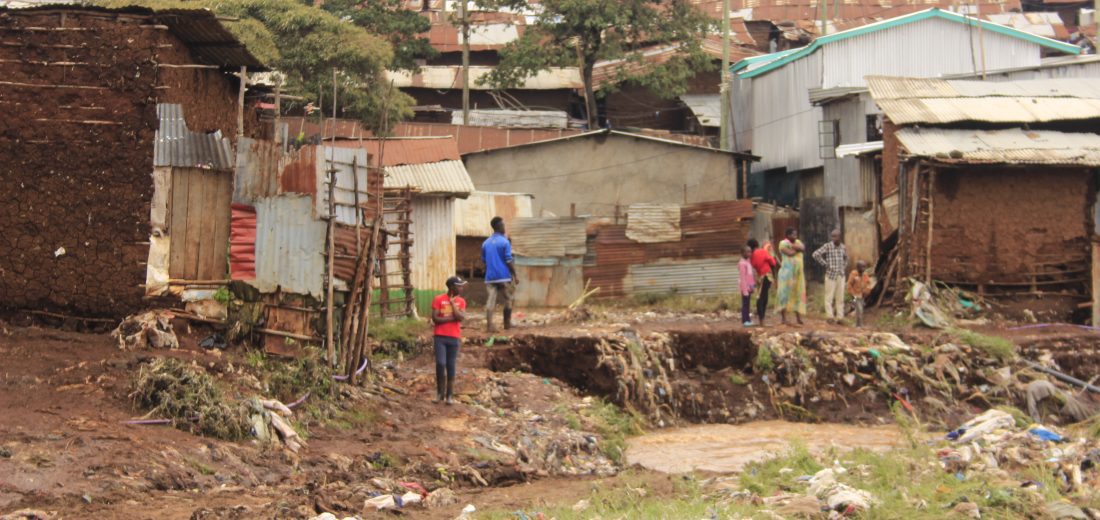
Residents of Kibera in Nairobi woke up to a morning of destruction and mourning after flesh floods swept through the area. This has become a common occurrence in the area every time it rains and it’s about time long lasting solutions were effected. The most practical solution is we plant trees instead of houses along the river banks. Vice Versa Global’s own Nicera Wanjiru, who grew up and resides in Kibera, narrates her experience on that particular day.
It is generally believed that rain is a blessing, and indeed it is. Yet, to some people, especially those in informal settlements, it sometimes morphs into a curse. Residents of Kibera slum in Nairobi are still in shock and mourning after the events of 14th of May, 2021. After a heavy down pour that pounded the city the previous night, three bodies were retrieved from Nairobi River. This happened at 10 o’clock that morning, with another body reported missing. Apart from that, properties were also destroyed by the raging floods and household items swept away. Even livestock like pigs were not spared either. On my way back home the following day, I was told that another man had been swept away by the floods as people watched. No one is yet to file a missing persons report with the police. Or worse, maybe the family is not even aware.
The Aftermath
As I walked along the bank of Nairobi River, I couldn’t help but wonder about the families that have rented houses along the river bank. Due to their low income, they can’t afford to live in better and safer places since these houses are very cheap. I was met with faces full of sadness and agony as I made my way through the area, with kids oblivious of what had happened the previous night. I approached a group of people which had formed a crowd around two lifeless bodies that lay wrapped in sheets. The mood was somber with people either silent or conversing in low tones. The deceased family was already resent at the scene, though they couldn’t move the body until the police showed up.

Yet another crowd, gathered around another lifeless body, looks angry and agitated as they wait for the police to come. A few minutes later, a police vehicle arrives but it keeps its distance at the sight of the angry chanting youth who are approaching it. It turns out that that particular car was actually on patrol and they had just requested for another vehicle to come. In the whole melee, I almost get lynched by the mob when I try to take a few photos. Lucky for me, some members of the mob know me and are familiar with my line of work, so I get out of it unharmed. In the process, I end up with my very own ‘security team’.
The Pole of Death
I am joined by two gentlemen who were in the rescue team, Yusuf and Mish, who are now acting as my security. The first site I’m taken to is where Bajaj, a victim, got stuck never to be seen again alive. He stepped on an electricity pole trying to pull a pipe out of the water. Unfortunately, he got stuck and was swept away by the heavy floods. A few meters from there, Yusuf points at where the body was retrieved at 6:30 in the morning. The victim’s house was only a few meters from the river. It is already lunch time and with the search having started at 11 pm the previous night, the search party hadn’t slept the whole time and looked weary.
The Pastor’s House
The second site is a pastor’s house, which is completely submerged in water. With the structure being constructed from mud, half of it is gone with only the wooden frames remaining.

Inside the structure, things have either been swept away or completely destroyed. This house is also very near the river, a stone’s throw away actually. As we are walking towards the third site, we bump into the pastor who looks confused as he ponders his next move. We stop him for a quick chat as I’m curious to know where he will spend the night.

“I had to seek refuge at my son’s house where I slept,” says the pastor. “I could have died.” I notice a look of fear in his eyes as he heads towards where his house used to stand. It’s obvious he hasn’t seen it yet and is afraid of what he might find.
The Grabbed River Bank
Due to a change in the usage of land, there has been a consistent encroachment on riparian land, couple that with the rate of urban growth, then the result is the usual flooding that we always witness in cities whenever it rains
One thing I have noticed and which is very common in informal settlements, is the invasion and occupation of all empty spaces. The situation is so dire that even the famous Nairobi River, which has its presence in all the major slums, has no breathing space In fact some structures are even constructed on top of the river. With no proper drainage system and garbage thrown everywhere, whenever it rains disaster is always bound to occur. So, who is to blame? Do the occupants of these houses know anything about environment conservation and preservation? Do they know the repercussions of their acts?
The government seems to have turned a blind eye to the issues that matter the most like climate change and environmental conservation.
Due to rural urban migration, this situation might be here with us for some time. With very few resources and houses available to the dwellers, they’re left with no other option but to scramble for the little there is. It is so bad that in some areas, we are actually seeing new structures being constructed on top of the existing ones.
Plant Trees Not Houses
“Let’s plant trees along the river banks not houses,” Malasen Hamida, the founder of Mazingira Community Based Organization told me. She has committed to planting 500,000 trees in slums and other parts of Nairobi, as well as restoring the Nairobi River to its former glory. Through her initiative she has also engaged both primary and secondary schools in planting trees. She has involved several youth groups along Nairobi River by providing for them seedlings and trees. Furthermore, she is very strict on garbage disposal as she is running a campaign called ‘usichome taka’ (don’t burn trash). “Burning trash increases the greenhouse gases which affect the ozone layer,” she said.

Malasen maintains that people should vacate the riparian land, plan well and open all the trenches. We should also plant trees along the river banks because they help in holding the soil firmly. She finishes by saying, “If the river course is left unobstructed and the water has its way, then there will be no flooding.”
Vice Versa Global is a platform spearheaded by young African journalists who are keen on telling the African story from the youth’s point of view by creating socially conscious content through vlogs, columns, video, articles and discussions in order to share ideas and spark dialogue about social change. Follow us on Twitter and Facebook.
https://web.facebook.com/viceversaglobal/
https://twitter.com/globalviceversa

Leave a Reply